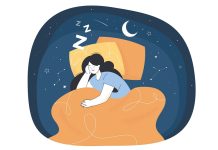
In a study from Uppsala University, scientists found that using a weighted blanket at bedtime increases melatonin in young adults.
This hormone increases in response to darkness, and some evidence suggests that it promotes sleep.
Previous research has shown that weighted blankets may ease insomnia in humans. However, the underlying mechanisms are not fully understood.
Hence, researchers experimented with 26 young men and women to examine if the bedtime use of a weighted blanket increases the production of sleep-promoting and anti-stress hormones like melatonin and oxytocin.
In addition, they examined whether the bedtime use of a weighted blanket (12% of participants’ body weight) reduced the activity of stress systems in the body.
To this end, saliva was collected repeatedly from participants while they were covered with either a weighted or a light blanket to measure melatonin, oxytocin, and cortisol.
The team found using a weighted blanket increased melatonin concentrations in saliva by about 30%.
However, no differences in oxytocin, cortisol, and the activity of the sympathetic nervous system were observed between the weighted and light blanket conditions.
This study may offer a mechanism explaining why weighted blankets may exert some therapeutic benefits, such as improved sleep.
However, the findings rely on a small sample and investigated only the acute effects of a weighted blanket.
Thus, larger trials are needed, including a study of whether the observed effects of a weighted blanket on melatonin are sustained over longer periods.
If you care about sleep, please read studies about the science on 3 traditional bedtime remedies, and how to deal with “COVID-somnia” and sleep well at night.
For more information about sleep, please see recent studies about how sleep affects human brain clearance, and results showing this drug could help treat insomnia and sleep loss.
The study was conducted by Elisa Meth et al and published in the Journal of Sleep Research.
Copyright © 2022 Knowridge Science Report. All rights reserved.



